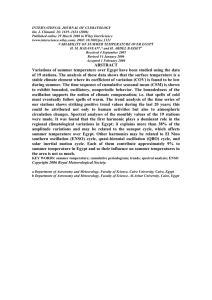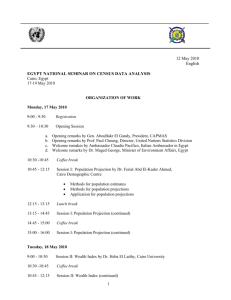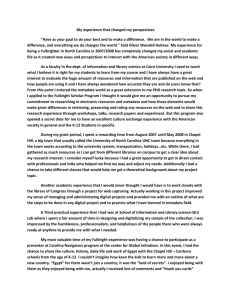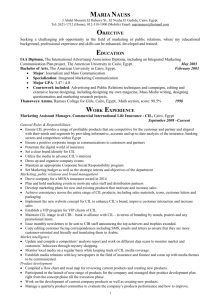Living and Conducting Research in Cairo, Egypt
advertisement
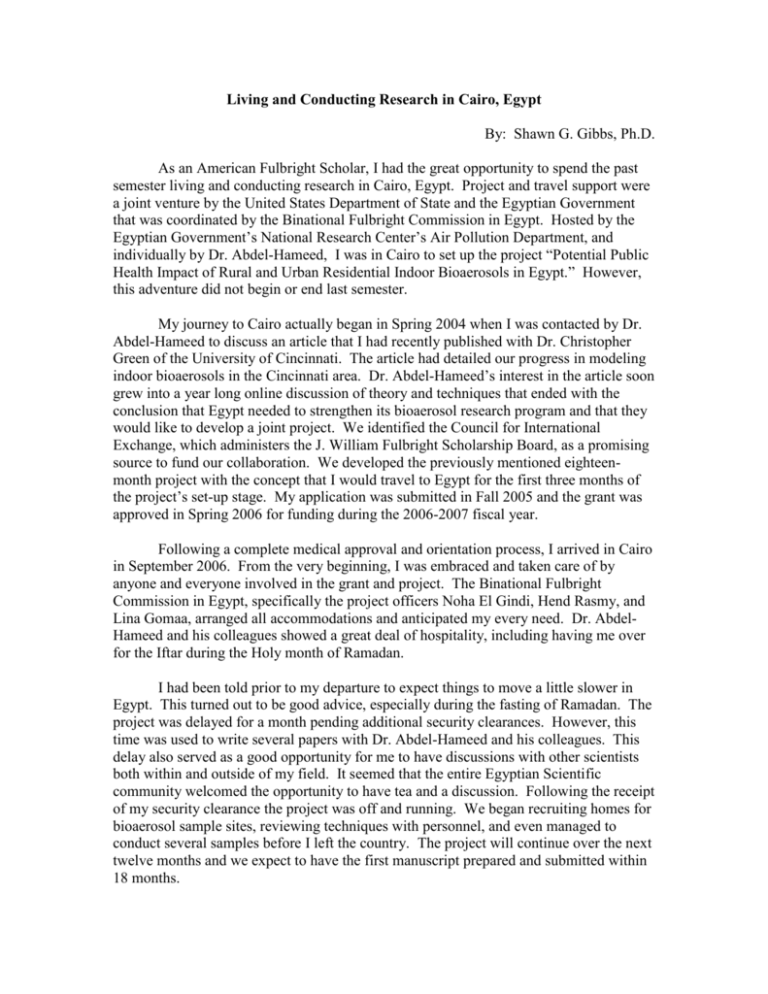
Living and Conducting Research in Cairo, Egypt By: Shawn G. Gibbs, Ph.D. As an American Fulbright Scholar, I had the great opportunity to spend the past semester living and conducting research in Cairo, Egypt. Project and travel support were a joint venture by the United States Department of State and the Egyptian Government that was coordinated by the Binational Fulbright Commission in Egypt. Hosted by the Egyptian Government’s National Research Center’s Air Pollution Department, and individually by Dr. Abdel-Hameed, I was in Cairo to set up the project “Potential Public Health Impact of Rural and Urban Residential Indoor Bioaerosols in Egypt.” However, this adventure did not begin or end last semester. My journey to Cairo actually began in Spring 2004 when I was contacted by Dr. Abdel-Hameed to discuss an article that I had recently published with Dr. Christopher Green of the University of Cincinnati. The article had detailed our progress in modeling indoor bioaerosols in the Cincinnati area. Dr. Abdel-Hameed’s interest in the article soon grew into a year long online discussion of theory and techniques that ended with the conclusion that Egypt needed to strengthen its bioaerosol research program and that they would like to develop a joint project. We identified the Council for International Exchange, which administers the J. William Fulbright Scholarship Board, as a promising source to fund our collaboration. We developed the previously mentioned eighteenmonth project with the concept that I would travel to Egypt for the first three months of the project’s set-up stage. My application was submitted in Fall 2005 and the grant was approved in Spring 2006 for funding during the 2006-2007 fiscal year. Following a complete medical approval and orientation process, I arrived in Cairo in September 2006. From the very beginning, I was embraced and taken care of by anyone and everyone involved in the grant and project. The Binational Fulbright Commission in Egypt, specifically the project officers Noha El Gindi, Hend Rasmy, and Lina Gomaa, arranged all accommodations and anticipated my every need. Dr. AbdelHameed and his colleagues showed a great deal of hospitality, including having me over for the Iftar during the Holy month of Ramadan. I had been told prior to my departure to expect things to move a little slower in Egypt. This turned out to be good advice, especially during the fasting of Ramadan. The project was delayed for a month pending additional security clearances. However, this time was used to write several papers with Dr. Abdel-Hameed and his colleagues. This delay also served as a good opportunity for me to have discussions with other scientists both within and outside of my field. It seemed that the entire Egyptian Scientific community welcomed the opportunity to have tea and a discussion. Following the receipt of my security clearance the project was off and running. We began recruiting homes for bioaerosol sample sites, reviewing techniques with personnel, and even managed to conduct several samples before I left the country. The project will continue over the next twelve months and we expect to have the first manuscript prepared and submitted within 18 months. During the course of the Semester I had the opportunity to deliver four symposiums on my work. Three symposiums on bioaerols were delivered to the National Research Center, Cairo University, and Mansoura University, respectively. A fourth symposium on biofilms was delivered at the National Research Center to a broad audience of researchers. All seemed to have been very well received. I also had the opportunity to serve on four grant review and interview panels for the Binational Fulbright Commission in Egypt on a variety of topics relating to Public Health. We selected Egyptian scholars and students who would conduct research in the United States. The trip was not all work; there was a fair bit of play. Aside from the numerous activities prepared by my hosts in Cairo I did do some traveling. I was joined in my final month by my girlfriend and we traveled the country for two weeks, and she has over five hundred pictures to prove it. The highlights include Alexandria, Aswan, Giza, Luxor, Mansoura, and present day Nubia (old Nubia lies beneath Lake Nasser). We saw dozens of Pyramids, although I don’t recommend going inside one like we did unless you are comfortable with tight, dark spaces; also, my legs were sore for a week. We visited the major and a number of the minor cultural treasures, including the Catacombs of Alexandria, Coptic and Islamic Cairo, the Egyptian Museum, Karnak, Philae, and Luxor Temples (to name a few), a host of tombs inside and outside of the Valley of the Kings, the Colossi of Memnon, and of course the High Dam. Overall, my experience as a Fulbright Scholar in Egypt was a very pleasant one. I was able to complete the goals of my trip, plus several others, and I was able to experience both the modern and historic aspects of Egypt. I welcome both the opportunity to return to Egypt and other international research opportunities.




